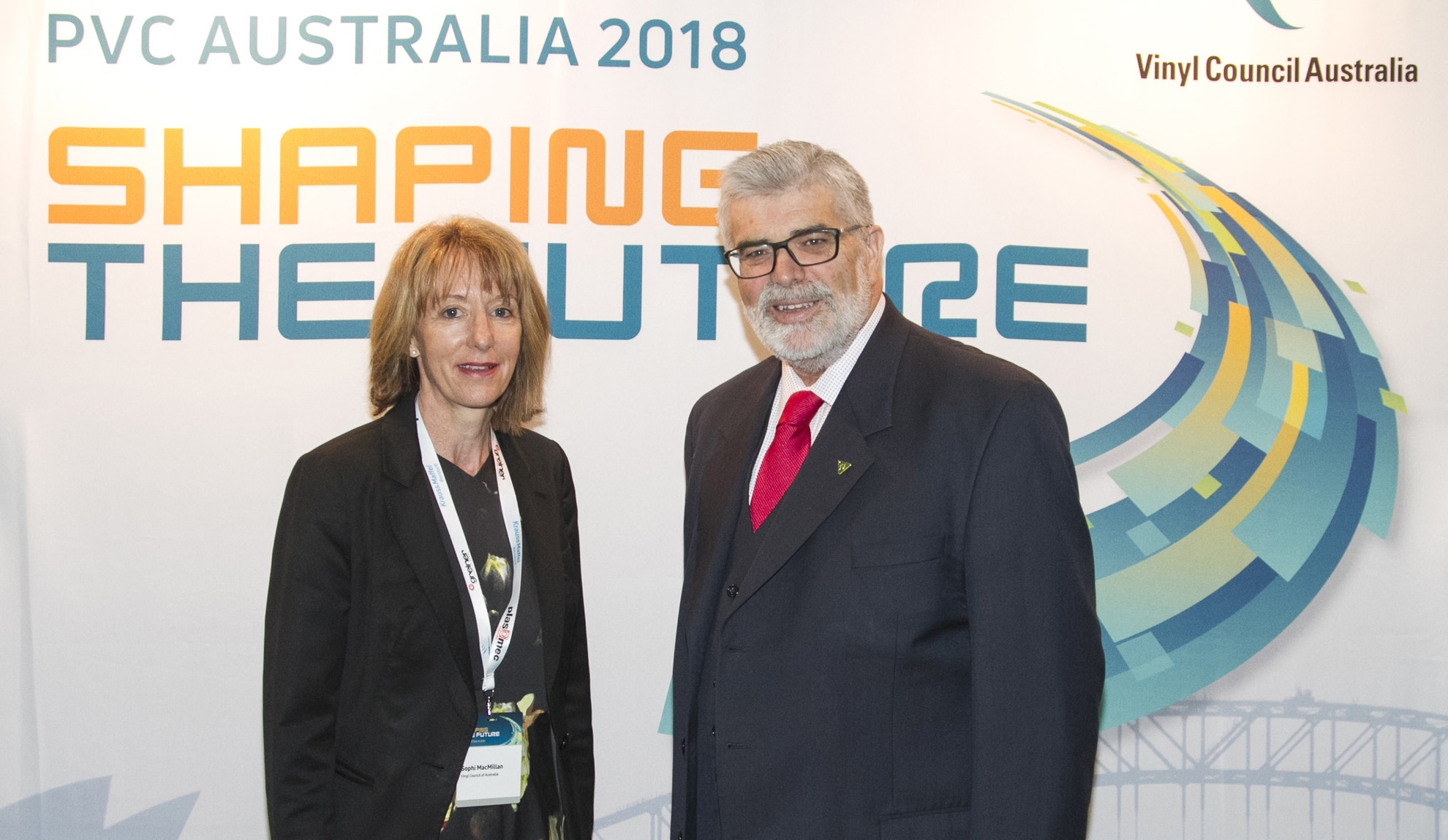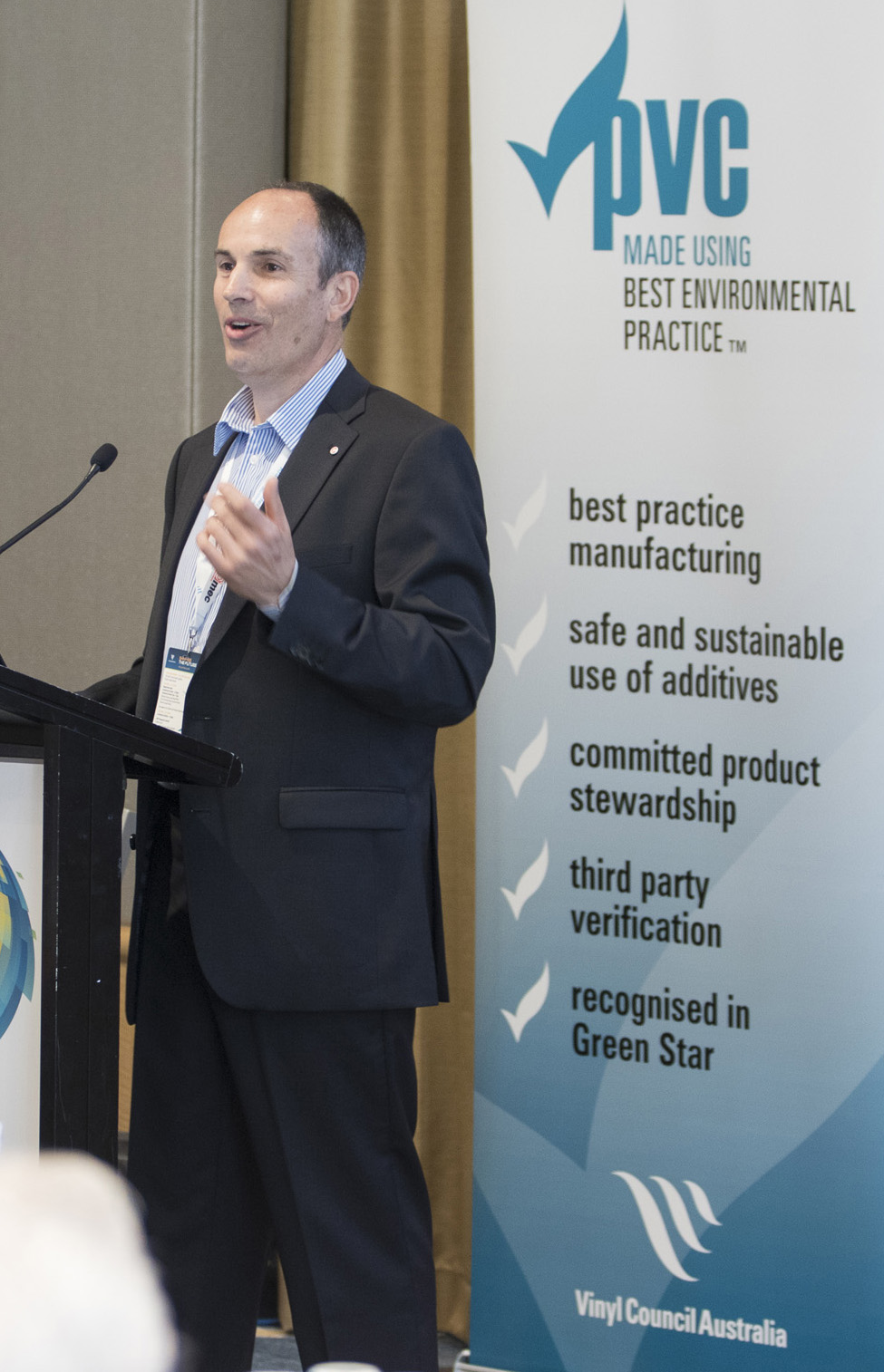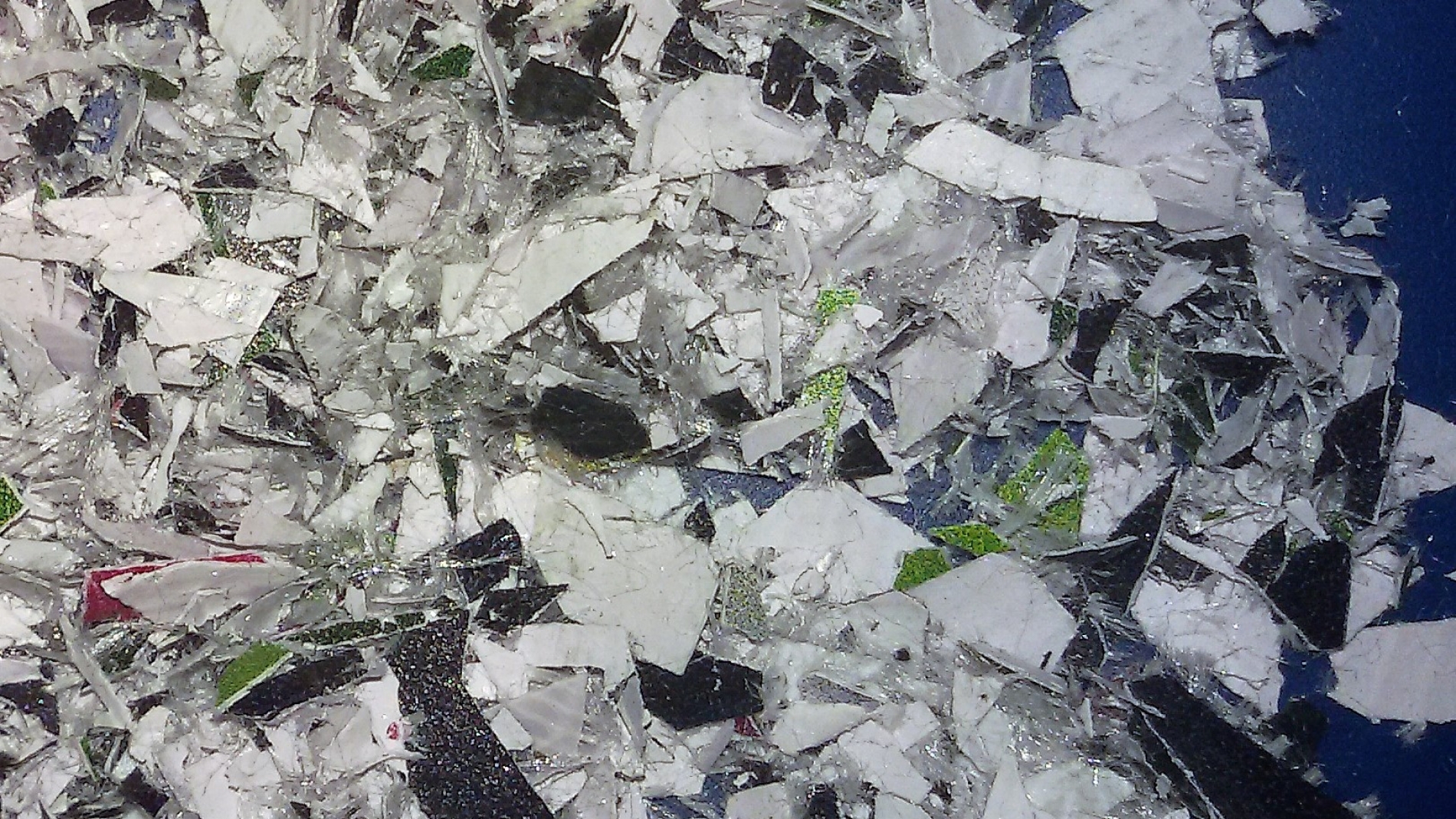Innovation and sustainability progress unveiled at PVC AUS 2018
Written by Super UserAdvances in technology, sustainability and product stewardship over the last 20 years have helped to transform the PVC sector across Australia and turn vinyl into a ‘sound choice of material’, delegates learnt at PVC AUS 2018: Shaping the Future.
Organised by the Vinyl Council of Australia in its 20th anniversary year, the two-day Sydney event in March shared latest developments in PVC formulations and best practice manufacturing that demonstrate the sector’s commitment to continuous improvement.
The event was supported by headline sponsors Austria-based Greiner Extrusion GmbH, Krauss-Maffei Berstorff from Munich, Germany and Italian machinery manufacturer PlasMec.
Vinyl Council Chief Executive Sophi Macmillan commented: “We are driving continuous improvement through the industry in Australia, for both locally-made and imported products, and this is driving change through PVC product supply chains.
“One of the longest standing product stewardship programs in Australia, our PVC Stewardship Program is leading in many areas. These include its life cycle approach, specific and measurable commitments, transparency, and focus on continuous improvement across the value chain.”
Currently 47 companies are Signatories to the Program, representing the majority of the Australian PVC industry. These companies include manufacturers of PVC resin, additives and end-products, PVC compounders and product importers. Major PVC applications represented in the Program include companies manufacturing or importing packaging, cables, windows, flooring, pipes, formwork, medical products, and profiles.
Among the industry successes Sophi highlighted were: a 99.45% reduction in lead additive use since 2002, the Signatories’ 90% compliance with the PVC Industry Energy and Greenhouse Gas Emissions Charter and several PVC recycling initiatives covering advertising banners, commercial vinyl flooring and medical devices.
In his US perspective on ‘Vinyl for a Purpose-Driven Sustainable Development’, Cristian Barcan, VP Sustainability & Industry Affairs at the Vinyl Institute covered key sustainability progress. This includes a 90% reduction in VCM emissions since 1983 and the elimination of lead and cadmium stabilisers. More than 450,000 tonnes of PVC are recycled annually in the US.
Cristian observed: “Unprecedented challenges lie ahead, we have to change. We don’t have three planets of natural resources; doing more with less is needed to address the needs of the next generation.”
Dr Tracy Wakefield of Plustec Pty Ltd outlined the benefits of uPVC Tilt n Turn windows and how their functionality, in terms of low-maintenance, ease-of-cleaning, security and superior ventilation are the future of windows in Australia – and crucially, suit its climate.
With 85% of windows installed in Australian homes still single-glazed, Gerhard Hoffmann of Greiner Extrusion emphasised how the insect-proof, thermally-efficient, 100% recyclable and corrosion-resistant properties of uPVC windows represent a cost-effective fenestration opportunity.
Advances in formulations were a key topic with Dane Tallen of stabiliser manufacturers Baerlocher exploring how calcium-based solutions could provide cost-effective and sustainable solutions for injection-moulding applications; while Dexter Chan from Arkema discussed the improved performance merits of acrylic impact modifiers in replacing chlorinated polyethylene (CPE) in rigid PVC.
Several updates on technology developments in the Australian PVC sector included a new chemical technology to separate PVC and laminated materials. Dennis Collins from PVC Separation explained how their two-stage chemical and environmentally-friendly process works for a variety of materials recycling, from PVC construction products to shoes, medical and food packaging items.
Dario Soncin of PlasMec covered latest developments in PVC dry blend preparation that can contribute to energy savings. Following him, Christian Birzer of Krauss-Maffei Berstorff revealed interesting advances in plastic processing machinery, including increasing the speed limit for pipe, increasing the production density and flexibility of pelletizing and narrowing the limits for u-PVC sheet extrusion.
Arjen Sevenster, Technical and Environmental Affairs Senior Manager at the European Council of Vinyl Manufacturers (ECVM) highlighted major sustainability progress in the European PVC industry and how the VinylPlus Voluntary Commitment is supporting the Circular Economy objectives for PVC.
Summing up, Sophi concluded: “With a high calibre of speakers and content, our conference attracted nearly 150 people and has been a huge success. It has demonstrated that PVC, as a durable, low-carbon plastic with the potential for circularity, can contribute to shaping a more sustainable future for all.”
|
|
||||
|
|
Vinyl Council CEO Sophi MacMillan with Senator Kim Carr
Terence Jeyaretnam, EY |
|
Gerhard Hoffmann, Greiner Extrusion |
|
Research paper on vinyl banner recycling published
Written by Super UserA paper by one of the Vinyl Council's research partners, Dr. Sagar T Cholake, Research Associate, Centre for Sustainable Materials Research & Technology, University of New South Wales, has been published in the journal Resources, Conservation and Recycling Volume 136, September 2018 related to the Council's vinyl banner recycling project.
The paper, ‘Cost-effective and sustainable approach to transform end-of-life vinyl banner to value added product’ details a potential, new low-cost solution for waste PVC coated fabrics that does not require the separation of the PVC from the polyester fabric, overcoming a major barrier to recycling.
Testing by the UNSW team indicated that waste PVC-coated banners could be used to fabricate strong and durable composite panels for multiple indoor and outdoor applications and the paper shows one example of final product.
Life cycle analysis, conducted as part of the research, showed that replacing virgin PVC by recycled PVC from banner emits 78% less greenhouse gas emissions (kg CO2 equivalent).
Access this paper through the online journal here.
More...
Senator Kim Carr to open PVC AUS 2018 conference
Written by Super UserSenator Kim Carr, Shadow Minister for Innovation, Industry, Science and Research, will be giving the opening address at PVC AUS 2018: Shaping the Future, Australia’s premier vinyl conference to be held in Sydney from 14 to 15 March 2018.
Organised by the Vinyl Council of Australia, high-level international speakers at the two-day event will explore the latest technical, market, innovation and sustainability trends impacting on Australasia’s PVC value chain.
On March 14, Senator Carr will update around 130 delegates on the Labor Party’s future vision for supporting innovation and development within its manufacturing sectors.
Worth an estimated $3 billion, Australia’s growing PVC industry directly employs more than 2,500 people. While around 85% of PVC is used in building and infrastructure products, from pipes to windows, the polymer’s versatility extends to myriad applications such as telecommunications, mining, health, food and agriculture to consumer goods.
Development of the local manufacturing base, from the creation of new growth markets in building products to reprocessing and recycling of end of life products, has been underpinned largely by the Vinyl Council of Australia and its members over the last two decades.
Vinyl Council Chief Executive Sophi MacMillan comments: “Here in Australia, we can demonstrate some world-leading examples of vinyl in areas ranging from healthcare to PVC pipe. Innovation in our sector has also seen great strides forward in areas such as wall construction systems, medical product recycling, 3D vinyl compounds and new recycling technology.
“We encourage and support policies that facilitate industry transition towards a resource efficient and circular economy, along with reducing the risk of non-conforming products being placed on the market.”
She adds: “Competition from non-conforming building products, such as cables, windows and plumbing, are significantly affecting our industry. So we would be interested to hear how the ALP plans to deliver frameworks that address this issue, as well as updates on its vision for the future of manufacturing and industry development in Australia.”
More information on the conference and its program can be found at vinyl.org.au/news/pvc-aus-2018
More than 30 expert speakers announced for PVC AUS 2018
Written by Super UserMore than 30 expert speakers from around the world will be sharing leading edge insight about the latest technical, market and sustainability trends in the vinyl industry at PVC AUS 2018: Shaping the Future.
Organised by the Vinyl Council of Australia, this two-day premier vinyl conference brings together Australasia’s vinyl value chain in Sydney from 13 to 15 March 2018. Supporting the event are headline sponsors Austria-based Greiner Extrusion GmbH, Krauss-Maffei Berstorff from Munich, Germany and Italian machinery manufacturer PlasMec.
In his global outlook for PVC supply/demand, Eddie Kok, Senior Director at IHS Chemical will provide expert analysis on pricing, supply/demand dynamics and whether supply will tighten in the next five years.
Sustainability developments in the European PVC industry and how the VinylPlus Voluntary Commitment is supporting the Circular Economy objectives for PVC will be covered by Arjen Sevenster, Technical and Environmental Affairs Senior Manager at the European Council of Vinyl Manufacturers (ECVM).
He will also discuss the ‘legacy substances’ issue, the development of an effective recycling system and an ‘Additives Sustainability Footprint’ methodology to evaluate the use of PVC additives from a sustainable development perspective.
Delegates will be updated on the American vinyl industry’s ‘journey of continuous improvement’ by Cristian Barcan, VP Sustainability & Industry Affairs at The Vinyl Institute. In his ‘Vinyl for a Purpose-Driven Sustainable Development’ talk, he will highlight current initiatives including an industry-wide materiality assessment, and how vinyl products can play a major leadership role in contributing to sustainable development.
Technological advances in processing and machinery will be explored by representatives from the event’s sponsors - Gerhard Hoffman, of Greiner Extrusion, Dario Soncin of Plasmec and Christian Birzer of Krauss Maffei.
Topics in this session include an overview on expanding market opportunities for PVC windows, latest developments in PVC mixing and how machine and processing technologies can prepare plastics manufacturers for future challenges.
PVC’s versatility and sustainability in construction applications include Andrew Swann of Tech Plas Extrusions Pty Ltd introducing TechBoard, an innovative product for a previously unexplored market; while David Baggs of Global Green Tag Pty Ltd will offer a comparative life cycle evaluation of PVC versus other flooring materials.
Recycling is another key theme to be examined by several speakers such as Dennis Collins, an Australian inventor of new recycling technologies for challenging waste materials. Creative concepts and ‘Wicked’ sustainable designs for tackling end-of-life PVC will be presented by Helen Millicer, the Vinyl Council’s Recycling Projects Manager and Mark Richardson from Monash University.
Economic, financial and construction market outlooks from leading commentators will conclude the comprehensive program.
Vinyl Council Chief Executive Sophi MacMillan comments: “Our second conference, PVC AUS 2018: Shaping the Future provides an unmatched opportunity for Council members and their stakeholders to learn about industry trends and developments specific to the manufacturing, use and re-use of vinyl.
“It’s the only event designed to shape the future of the vinyl industry in the region. We look forward to welcoming – and inspiring - you in Sydney!”
The Vinyl Council of Australia has launched a new conference app for mobile and tablet devices to keep PVC AUS 2018 delegates and prospective attendees up to date with all the very latest information about their biennial event.
Available for both Android and Apple devices, the convenient conference tool is designed to deliver all of the latest news and updates in one place.
As well as being a useful on-the-day tool for the two-day conference in Sydney from 13 to 15 March 2018, the free app also includes all the key information needed ahead of the event, including the very latest program, speaker, sponsor and exhibitor information.
PVC AUS 2018: Shaping the Future is Australia’s premier vinyl conference. Organised by the Vinyl Council of Australia, it brings together Australasia’s vinyl value chain to meet, educate and innovate. In a packed program, more than 30 expert speakers from around the world will be sharing leading edge insight about the latest technical and market trends in the vinyl industry.
Commenting on the App, Vinyl Council Chief Executive Sophi MacMillan says: “We recognise the advantages of having a custom mobile app that provides all the information you’ll need at your fingertips to enjoy the whole event.
“We will be keeping this current from now to the close of the conference, so stay in touch with all things PVC AUS 2018 by downloading the ‘pvc aus 18’ app to your mobile or tablet now.”
If you’ve still not registered for the event at the Amora Hotel Jamison Sydney, you can book directly via the app, or here.
PVC AUS 2018 set to debate global plastic issues
Written by Super UserSignificant economic trends and sustainability progress in the PVC value chain will be explored by a host of global experts at the two-day PVC AUS 2018: Shaping the Future, Australia’s premier vinyl conference, in Sydney next March.
Organised by the Vinyl Council of Australia, the two-day event from 13 to 15 March will cover current and future issues influencing the PVC value chain, from additives, processing and technology to the material’s role in construction, industry and future sustainable development.
Supporting the event are headline sponsors Austria-based Greiner Extrusion GmbH, Krauss-Maffei Berstorff from Munich, Germany and Italian machinery manufacturer PlasMec.
Announcing the packed program, Vinyl Council Chief Executive Sophi MacMillan says: “Places are filling up fast for the only conference that brings together Australasia’s vinyl value chain to meet, educate and innovate as this sector moves towards greater sustainability. It promises to be a stimulating event for all involved in this global market.”
Australia’s PVC manufacturing industry consumes more than A$1 billion of raw materials and over A$3 billion of products containing PVC are sold in Australia. Top-level international speakers discussing topics related to this sector and worldwide will include government and industry leaders, technical experts and commercial representatives from Australia and overseas.
Expert speakers will include Eddie Kok, Senior Director at IHS Chemical whose global outlook for PVC supply/demand will provide an insight on pricing direction. Arjen Sevenster, Technical and Environmental Affairs Senior Manager at the European Council of Vinyl Manufacturers (ECVM) will talk about how the VinylPlus Voluntary Commitment supports the Circular Economy objectives for PVC and outline the forthcoming EU’s Plastic Strategy on plastic recycling and reuse.
Among the speakers on technological advances will be Nigel Jones, Technical Manager at Australian Vinyls outlining new developments in performance and delivery of PVC for that market, while Stuart Douglas of Innovyz and Dennis Collins at PVC Separation will explain a new fast and eco-friendly chemical technology to separate PVC laminated materials that provides an Australian solution to a challenging waste stream.
In the Trends in Additives session, Dane Tallen, Technical Sales Manager at Baerlocher UK Ltd, will update delegates on an innovative Ca-based solution that fits all PVC injection moulding requirements.
Recycling will be a theme pursued by several speakers such as Michael Barnacoat of ProGeneus, explaining how their innovative Resysta product can reduce building waste and pollution using rice husks and PVC. Following him, Helen Millicer, the Vinyl Council’s Recycling Projects Manager and Mark Richardson from Monash University will showcase sustainable and creative design concepts for tackling end-of-life PVC.
Sophi adds: “Our second conference provides a unique opportunity for Council members and their stakeholders to share knowledge and identify the challenges and drivers for the future. It’s a much-anticipated event and we look forward to welcoming you there!”
| Download the Program |
HEADLINE SPONSORS
 |
 |
 |
FUNCTION SPONSORS
REGISTER NOW!
Special rates available for Vinyl Council of Australia members. There are further discounts for company group bookings of three or more delegates, and great rates for social partners to join the welcome reception and dinner.
Register through TryBooking.com.
















